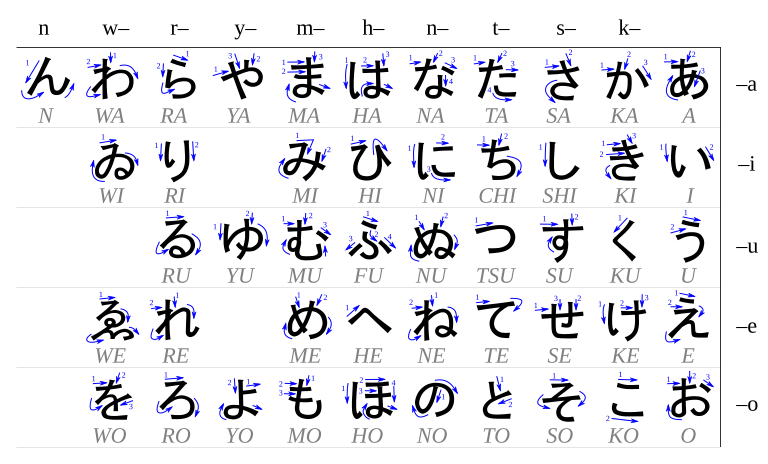Hiragana
The word hiragana means "common" or "plain" kana (originally also "easy", as contrasted with kanji).
[5] Words that do have common kanji renditions may also sometimes be written instead in hiragana, according to an individual author's preference, for example to impart an informal feel.
After the 1900 script reform, which deemed hundreds of characters hentaigana, the hiragana syllabary consists of 48 base characters, of which two (ゐ and ゑ) are only used in some proper names: These are conceived as a 5×10 grid (gojūon, 五十音, "Fifty Sounds"), as illustrated in the adjacent table, read あ (a), い (i), う (u), え (e), お (o), か (ka), き (ki), く (ku), け (ke), こ (ko) and so forth (but si→shi, ti→chi, tu→tsu, hu→fu, wi→i, we→e, wo→o).
Hiragana beginning with an h (or f) sound can also add a handakuten marker ( ゜) changing the h (f) to a p. For example, は (ha) becomes ぱ (pa).
In Japanese this is an important distinction in pronunciation; for example, compare さか, saka, "hill" with さっか, sakka, "author".
The chōonpu (long vowel mark) (ー) used in katakana is rarely used with hiragana, for example in the word らーめん, rāmen, but this usage is considered non-standard in Japanese.
In informal writing, small versions of the five vowel kana are sometimes used to represent trailing off sounds (はぁ, haa, ねぇ, nee).
The following table shows the complete hiragana together with the modified Hepburn romanization and IPA transcription, arranged in four categories, each of them displayed in the gojūon order.
[11] In many accents, the j and z sounds are pronounced as affricates ([d͡ʑ] and [d͡z], respectively) at the beginning of utterances and fricatives [ʑ, z] in the middle of words.
However, とう tou is pronounced [toɯ] 'to inquire', because the o and u are considered distinct, u being the verb ending in the dictionary form.
Similarly, している shite iru is pronounced [ɕiteiɾɯ], present progressive form of する (suru, "to do").
In archaic forms of Japanese, there existed the kwa (くゎ [kʷa]) and gwa (ぐゎ [ɡʷa]) digraphs.
With a few exceptions, such as for the three particles は (pronounced [wa] instead of [ha]), へ (pronounced [e] instead of [he]) and [o] (written を instead of お), Japanese when written in kana is phonemically orthographic, i.e. there is a one-to-one correspondence between kana characters and sounds, leaving only words' pitch accent unrepresented.
The second component, 妻 (etymologically 夫), meaning 'spouse', is pronounced つま (tsuma) when standalone or often as づま (zuma) when following another syllable, such in 人妻 (hitozuma, 'married woman').
Even though these components of 稲妻 are etymologically linked to 'lightning', it is generally arduous for a contemporary speaker to consciously perceive inazuma as separable into two discrete words.
Although these rules were officially established by a Cabinet Notice in 1986 revising the modern kana usage, they have sometimes faced criticism due to their perceived arbitrariness.
However, づら zura 'wig' (from かつら katsura) and づけ zuke (a sushi term for lean tuna soaked in soy sauce) are examples of word-initial づ today.
syllables, and there are minimal pairs such as きんえん kin'en 'smoking forbidden', きねん kinen 'commemoration', きんねん kinnen 'recent years'.
For example, past prime minister Junichiro Koizumi's first name is actually じゅんいちろう Jun'ichirō pronounced [dʑɯɰ̃itɕiɾoː] There are a few hiragana that are rarely used.
Though ye did appear in some textbooks during the Meiji period along with another kana for yi in the form of cursive 以.
Today it is considered a Hentaigana by scholars and is encoded in Unicode 10[12] (𛀆) [13][14] This kana could have a colloquial use, to convert the combo yui (ゆい) into yii (𛀆い), due to other Japanese words having a similar change.
[15] An early, now obsolete, hiragana-esque form of ye may have existed (𛀁 [je][16]) in pre-Classical Japanese (prior to the advent of kana), but is generally represented for purposes of reconstruction by the kanji 江, and its hiragana form is not present in any known orthography.
While hiragana and katakana letters for "ye" were used for a short period after the advent of kana, the distinction between /ye/ and /e/ disappeared before glyphs could become established.
[24] For example, The Tale of Genji and other early novels by female authors used hiragana extensively or exclusively.
The pangram poem Iroha-uta ("ABC song/poem"), which dates to the 10th century, uses every hiragana once (except n ん, which was just a variant of む before the Muromachi era).
In the following character sequences a kana from the /k/ row is modified by a handakuten combining mark to indicate that a syllable starts with an initial nasal, known as bidakuon [ja].
As of Unicode 16.0, these character combinations are explicitly called out as Named Sequences: 「かたかな」の「かた」は単に「片方」という意味ではなく、本来あるべきものが欠落しているという評価形容語と解すべきことはよく知られているが(亀井孝1941)、(7)としてまとめた対立関係から考えると、「ひらがな」も同様に「かな」の「ひら」という評価位置に存在するものと考えられる。本国語大辞典「ひらがな」の説明は「ひら」を「角のない、通俗平易の意」とし、また「ひら」を前部要素とする複合語の形態素説明で、多くの辞書は「ひら」に「たいら」という意味を認める。しかし、辞書の意味説明が必ずしも原義説明を欲してはいないことを知りつつも、野暮を承知でいうならば、これは「ひら」の原義(中核的意味)説明としては適当ではない。「ひら」は、「枚」や擬態語「ひらひら」などと同根の情態言とでもいうべき形態素/ pira /であり、その中核的意味は、物理的/精神的な「薄さ」を示し、「たいら」はそこからの派生義と思われる。となると、「ひらがな」に物理的「薄さ」(thinness)は当然求められないので、「ひら」とはより精神的な表現に傾き、「かたかな」同様、「かな」から見て、ワンランク下であることを示す、いささか差別的・蔑視的ニュアンスを含む表現であったということになる。The "kata" in "katakana" does not mean just "one side", and it is well known (Takashi Kamei 1941) that it should be interpreted as a valuation epithet stating that something that should be there is missing, and considering the oppositional relationship summarized in figure (7), the word "hiragana" can be thought of in a valuation position as the "hira" kind of "kana".The explanation of the term hiragana in the Nihon Kokugo Daijiten dictionary states that hira means "unangular, easy for common people", and descriptions of hira as a prefixing element in compounds as given in many dictionaries explain this hira as meaning "flat" (taira).However, knowing that dictionary explanations of meaning do not always drive for the original senses, if we are to be brash, we might point out that this is not a fitting explanation of the original sense (core meaning) of hira.
Hira is morpheme /pira/, cognate with words like 枚 (hira, "slip of paper, cloth, or something else flat") or ひらひら (hirahira, "flutteringly"), and the core meaning indicates physical or emotional "thinness", and taira ("flat") appears to be a derived meaning therefrom.


